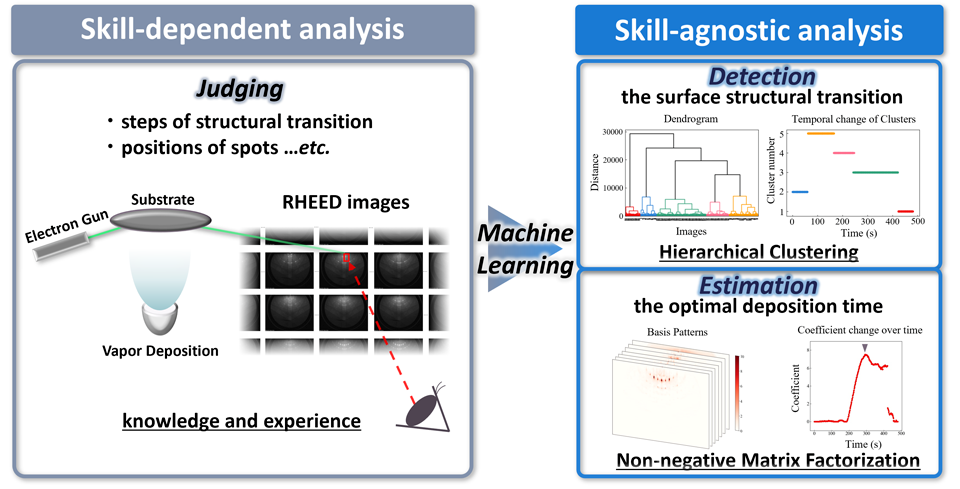The emergence of new thin semiconductor materials necessitates a quantitative analysis of the entire amount of RHEED records, which is time-consuming and involves expertise. To address this issue, researchers from the Tokyo University of Science identified a machine learning approach that can aid in the automation of RHEED data analysis.
 Reflection high-energy electron diffraction (RHEED) is an imaging technique widely used to analyze the surface structures of materials grown via physical vapor deposition. However, RHEED produces huge amounts of data and is a skill-intensive tool to use. To address this issue, TUS and NIMS scientists employ machine learning techniques to automate some of the harder parts of the analysis. Image Credit: Naoka Nagamura from the National Institute for Materials Science and Tokyo University of Science.
Reflection high-energy electron diffraction (RHEED) is an imaging technique widely used to analyze the surface structures of materials grown via physical vapor deposition. However, RHEED produces huge amounts of data and is a skill-intensive tool to use. To address this issue, TUS and NIMS scientists employ machine learning techniques to automate some of the harder parts of the analysis. Image Credit: Naoka Nagamura from the National Institute for Materials Science and Tokyo University of Science.
Their discoveries have the potential to significantly accelerate semiconductor studies and lay the groundwork for faster, more energy-efficient electronic devices.
Since its inception in the mid-twentieth century, the semiconductor industry has grown significantly, paving the way for the quick digitalization of society through the high-speed communication and information technology it facilitated. Presently, as global energy demand tightens, there is a huge market for quicker, more unified, and energy-efficient semiconductor devices.
Moreover, advanced semiconductor methods have already attained the nanometer scale, and the structural analysis of semiconductor nanofilms is now used in the design of new high-performance materials.
RHEED (reflection high-energy electron diffraction) is a popular analytical technique for this objective. RHEED can be used to evaluate the atomic structures that develop on the surface of thin films and could even acquire structural adjustments as the thin film is synthesized.
Unfortunately, despite its many advantages, RHEED is occasionally exacerbated by the fact that its production trends are complicated to define. In almost all cases, a highly qualified experimenter is required to make sense of the massive amounts of data produced by RHEED in the type of diffraction patterns. So what if researchers could make machine learning do the majority of the work when it comes to RHEED data analysis?
Dr. Naoka Nagamura, a visiting associate professor at Tokyo University of Science (TUS) and a senior researcher at Japan’s National Institute for Materials Science (NIMS), has directed a group of researchers in this effort.
The group studied the potential of using machine learning to automatically analyze RHEED data in their most recent study, which was published online on 9th June 2022, in the international journal Science and Technology of Advanced Materials: Methods.
TUS and NIMS, Japan, collaborated on this project, which was funded by JST-PRESTO and JST-CREST. Ms. Asako Yoshinari, Prof. Masato Kotsugi of TUS, and Dr. Yuma Iwasaki of NIMS contributed to the paper.
The scientists concentrated on the surface superstructures that develop on the initial atomic layers of pure single-crystal silicon (one of the most versatile semiconductor materials), which depends on the number of indium atoms adsorbed and minuscule temperature variations.
Atoms stabilize in different periodic patterns than those found inside the body of the crystal in surface superstructures, which are atomic arrangements specific to crystal surfaces that depend on variations in the environment. Surface superstructures are of great interest to materials research because they frequently display distinctive physical features.
To group samples into distinct clusters based on various metrics of similarity, the team’s first step was to employ several hierarchical clustering techniques. This method is used to count the number of various surface superstructures. After experimenting with several methods, the scientists discovered that Ward’s method could most effectively monitor the real phase transitions in surface superstructures.
The next step was to identify the ideal process parameters for creating each of the surface superstructures that had been found. The main focus was on the indium deposition time for which each superstructure was most thoroughly created.
Other common techniques for dimensionality reduction, such as principal component analysis, did not work effectively. Remarkably, the best deposition timings for each superstructure could be precisely and autonomously determined using non-negative matrix factorization, a distinct clustering and dimensionality reduction method.
Our efforts will help automate the work that typically requires time-consuming manual analysis by specialists. We believe our study has the potential to change the way materials research is done and allow scientists to spend more time on creative pursuits.
Dr. Naoka Nagamura, Visiting Associate Professor, Tokyo University Of Science
Overall, the results of this work should lead to innovative and practical applications of machine learning for materials science, a key area of materials informatics. As a result, since current products and technology are improved with better materials, this would have an impact on how humans live their daily lives.
“Our approach can be used to analyze the superstructures grown not only on thin-film silicon single-crystal surfaces, but also on metal crystal surfaces, sapphire, silicon carbide, gallium nitride, and various other important substrates. Thus, we expect our work to accelerate the research and development of next-generation semiconductors and high-speed communication devices,” concludes Dr. Nagamura.
Upcoming discoveries that help automate difficult data processing and reduce the effort for scientists are absolutely something researchers expect to see more of.
Journal Reference:
Yoshinari, A., et al. (2022) Skill-Agnostic analysis of reflection high-energy electron diffraction patterns for Si (111) surface superstructures using machine learning. Science and Technology of Advanced Materials: Methods. doi.org/10.1080/27660400.2022.2079942.